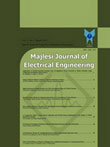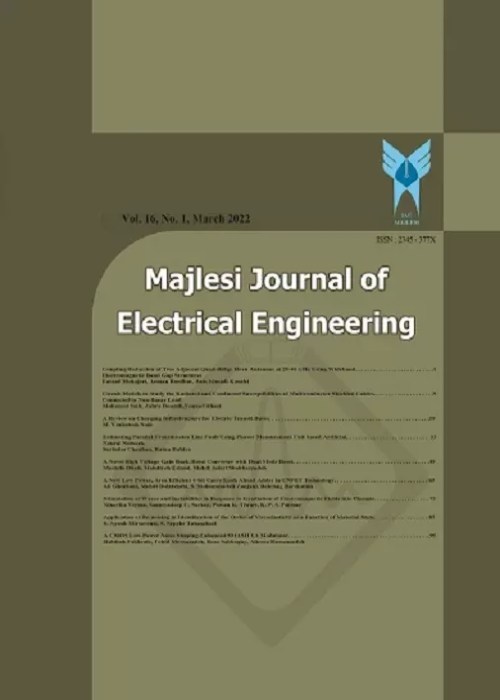فهرست مطالب

Majlesi Journal of Electrical Engineering
Volume:9 Issue: 1, Mar 2015
- تاریخ انتشار: 1394/01/25
- تعداد عناوین: 7
-
Pages 1-8Most industrial processes are characterized with large uncertainties. To deal with these kinds of processes and achieve fast and accurate control in a stable fashion, the multiple-model control methods have been demonstrated to be very effective. It is difficult to build the precise mathematic model of the object and to accurately control the object with the traditional control methods. This paper applies H∞ robust control strategies to a 24-tray separating a mixture of methanol and water. The idea has favorable controls on control targets (rise time, settling time, overshoot and undershoot, the interaction between input and output) and help on stability of the system output. Then in order to show that the proposed controller affords a good robust performance consistently we have implemented four controllers.Performance analysis of the Hinfinityrobust controller, Model Predictive Control (MPC), conventional PID controller and also LQG/LTR has been done using MATLAB. The comparison of various time domain parameters was done to prove that the H∞ robust controller has best time characteristics and in face with uncertainties has better reacts as compared to other controllers. Beside this, MPC controller has satisfied result in robust stability.Keywords: H, Infinity Robust Controller, PID Controller, Model Predictive Control, LQG, LTR Controller, Uncertainty
-
Pages 9-19This paper presents an advanced optimization technique to solve unit commitment problems and reliability issues simultaneously for thermal generating units. To solve unit commitment, generalized benders decomposition along with genetic algorithm to include minimum up/down time constraints are proposed, and for reliability issues consideration, a fuzzy stochastic-based technique is presented. To implement the problem into an optimization program, the MATLAB software, and CPLEX and KNITRO solvers are used. To verify the proposed technique and algorithm, two case studies that are IEEE 14 and 118 bus systems are implemented for optimal generation scheduling, and reliability issues. Finally, a comparison with other solution techniques has been given.Keywords: Benders Decomposition, Fuzzy Programming, Genetic Algorithm, Optimization Technique, Reliability Issues, Unit Commitment
-
Pages 21-24Rolling mill Industry is one of the most profitable industries in the world. Chatter phenomenon is one of the key issues in this industry. Chatter or rolling unwanted vibrations not only has an adverse effect on product quality, but also reduces considerably the efficiency with reduced rolling velocities of rolling lines.This paper is an attempt to simulate the phenomenon of Chatter more accurate than the previous performed simulations. In order to increase the production speed, it needs to avoid parameters which effect on the Chatter and varieties with the rolling lines condition. Actual values of these parameters were determined in the archives of the Mobarakeh two stand cold rolling mills and collected on the 210 case study of real chattering. To simulate the experiment, a neural network is trained and weights and bias values of the neural network with genetic optimization algorithm were used to get an optimal neural network which reduces bugs on the test data. So this model is capable to predict speed of Chatter threshold on rolling process of two stand cold rolling mill with the accuracy less than one percent. So it can be used in rolling process with the building intelligent recognition systems to prevent the creator conditions of the chatter frequency range.Keywords: Cold Rolling Mill, Chatter, Genetic Algorithms, Neural Networks
-
Pages 25-35In this paper, a new approach is investigated for order reduction based on Legendre expansion. Harmony Search is used in this approach, to determine the reduced order model's parameters. The Routh criterion is applied to specify the stability conditions. Then, the stability conditions are constraints in optimization problem. To present the efficiency of the proposed method, three test systems are reduced. The obtained results were compared to other existing techniques. The comparison showed that the proposed approach performs well.Keywords: Harmony Search Algorithm, Legendre Expansion, Order Reduction, Routh Array, Stability Constraints
-
Pages 37-53This article proposes a hybrid global-local algorithm - Hybrid Particle Swarm Optimization (HPSO) - applied to solve the Economic Dispatch (ED) problem. The HPSO algorithm combines the classical Particle Swarm Optimization (PSO) with the Conjugate Gradient (CG) non-linear optimizing method, included in the optimizing tool within MathCAD commercial software product. The global optimizer is the PSO algorithm, and the local one is the CG method. Two variants including the CG within the PSO, which are analyzed, called HPSO-RC (randomly controlled) and HPSO-RU (randomly uncontrolled). Both PSO and CG methods are easy to implement and together help reaching the best solution. The HPSO algorithm’s ability to avoid premature convergence and provide a stabile solution is tested on three systems consisting of 6, 13 and 38 thermal generating units. The HPSO algorithm’s efficiency in solving the ED problem is shown through a comparison with several other recently published algorithms.Keywords: Economic Dispatch, Transmission Losses, Particle Swarm Optimization, Hybridization, Optimizing Tool
-
Pages 55-83With the increasing demand for image-based applications, the efficient and reliable evaluation of image quality has increased in importance. Measuring the image quality is of fundamental importance for numerous image processing applications, where the goal of image quality assessment (IQA) methods is to automatically evaluate the quality of images in agreement with human quality judgments. Numerous IQA methods have been proposed over the past years to fulfill this goal. In this paper, a survey of the quality assessment methods for conventional image signals, as well as the newly emerged ones, which includes the high dynamic range (HDR) and 3-D images, is presented. A comprehensive explanation of the subjective and objective IQA and their classification is provided. Six widely used subjective quality datasets, and performance measures are reviewed. Emphasis is given to the full-reference image quality assessment (FR-IQA) methods, and 9 often-used quality measures (including mean squared error (MSE), structural similarity index (SSIM), multi-scale structural similarity index (MS-SSIM), visual information fidelity (VIF), most apparent distortion (MAD), feature similarity measure (FSIM), feature similarity measure for color images (FSIMC), dynamic range independent measure (DRIM), and tone-mapped images quality index (TMQI)) are carefully described, and their performance and computation time on four subjective quality datasets are evaluated. Furthermore, a brief introduction to 3-D IQA is provided and the issues related to this area of research are reviewed.Keywords: Image Quality Assessment (IQA), High Dynamic Range (HDR) Images, Full, Reference (FR), Reduced, Reference (RR), No, Reference (NR)
-
Pages 85-92This paper intends to provide an algorithm of fault resistance compensation for digital ground distance relay considering the voltage and current transformer effects. Performance of the conventional ground distance relaying manner is adversely affected by different ground faults and also typical type, called a simultaneous open conductor and ground fault. The proposed scheme by using local-end data only, has shown satisfactory performances under wide variations in fault location, with different values of fault resistance and having positive and negative of power transfer angle. The presented method which has been carried out on the IEEE 14 bus benchmark is executed in PSCAD/EMTDC and MATLAB software and the results show the accurate performance of mention configuration.Keywords: Digital Ground Distance Relaying, Fault Resistance Compensation, Voltage, Current Transformer, Single Phase to Ground Fault, Simultaneous Open Conductor, Ground Fault


